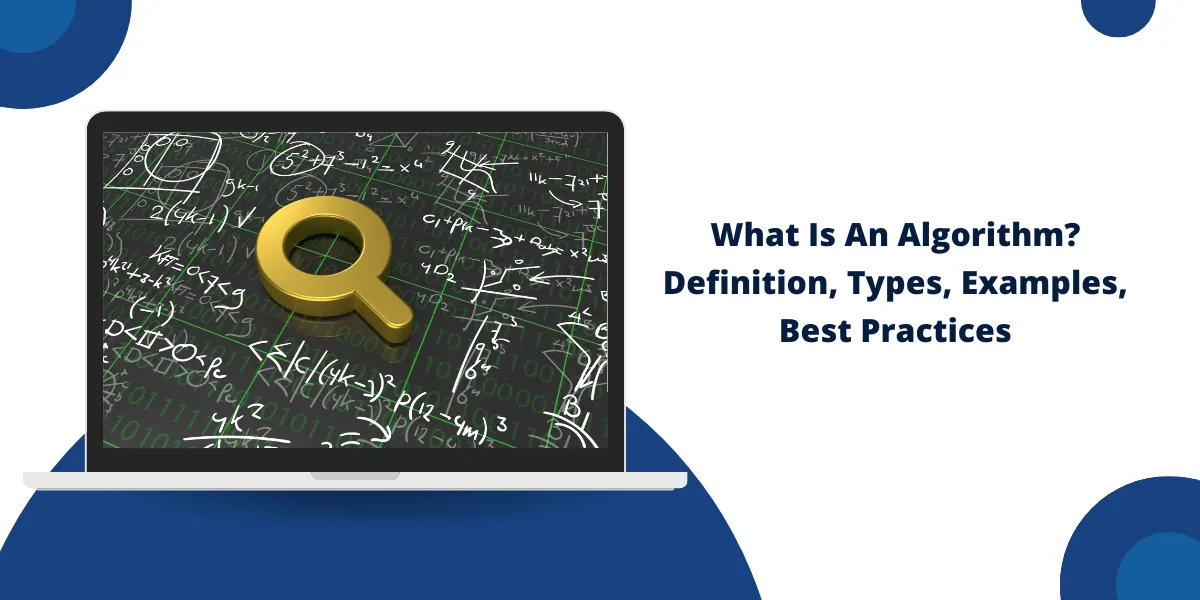Introduction to Algorithms
An algorithm is a well-defined computational procedure that takes some inputs or initial data and generates some outputs or results. The key properties of an algorithm are:
- It has definite, precise, and unambiguous instructions.
- It has a finite number of steps.
- It produces a reliable output or result.
- It can be executed by an electronic computing device or human agent by following the procedure systematically.
In other words, an algorithm is a step-by-step procedure for solving a problem in a finite amount of time. The steps provide unambiguous instructions for arriving at the desired output from a given input.
Algorithms are fundamental to computing and data processing. They tell computers and machines how to process data correctly and efficiently. Without algorithms, computers would not know how to execute tasks like sorting numbers, finding a piece of information in a database, routing network traffic, and performing countless other vital functions.
Beyond computing, algorithms are used to process information and solve real-world problems in fields like mathematics, science, engineering, manufacturing, business, and more. Any repetitive process that follows a sequence of steps can be automated as an algorithm.
Key Takeaways
- An algorithm is a set of instructions for solving a problem or completing a task.
- Algorithms have defined inputs, outputs, and steps. They are precise, unambiguous, and executable.
- Algorithms are used extensively in computer science for programming and computing tasks. They also have applications in mathematics, science, engineering, business, and many other fields.
- Algorithms can be classified by their complexity, design paradigm, purpose, and more. Common classes include recursive, divide-and-conquer, dynamic programming, greedy, and more.
- Algorithm analysis evaluates properties like correctness, time and space complexity, optimality, and more. Analysis helps select the most efficient algorithm for a task.
- Key algorithm concepts include brute force, greedy approach, recursion, hashing, sorting, searching, graph algorithms, and more.
Origins and History of Algorithm
The fundamental ideas of algorithms have been around for centuries. Ancient cultures like the Babylonians, Greeks, and Chinese used algorithmic procedures for tasks like multiplication, division, and finding square roots.
The modern study of algorithms was galvanized in the 20th century with Alan Turing’s work on computability and algorithms for computers. The origins of algorithm analysis date back to the 1950s and 1960s, when computer scientists and mathematicians did work.
In computer programming, algorithms allow software developers to reuse tried and tested procedures instead of solving every problem from scratch. The collection of algorithms implemented in a programming language is contained in its standard library.
Today, algorithms research remains an active domain in computer science. New algorithms are continuously developed to solve emerging problems. The design and analysis of efficient algorithms are crucial for the performance of software and information systems.
What are the Applications and Uses of Algorithms
Some key applications and uses of algorithms:
- Data processing: Algorithms enable efficient data processing and analysis in fields like statistics, machine learning, and data mining. Common data algorithms include sorting, searching, hashing, and various machine-learning models.
- Computing tasks: Fundamental algorithms are needed for essential computer functions like allocating resources, communicating data, operating systems, file storage, and more. These system-level algorithms handle computational tasks efficiently.
- Automation: Automating repetitive human tasks through step-by-step algorithms results in productivity gains. Applications include manufacturing, logistics, transportation, and more.
- Artificial Intelligence: AI algorithms can learn from data, identify patterns, predict outcomes, make recommendations, and mimic human intelligence for applications like computer vision, speech recognition, game-playing, and more.
- Scientific computing: Algorithms are used to model real-world phenomena, simulate experiments, and analyze scientific data across fields like physics, chemistry, biology, medicine, climate science, and more.
- Cybersecurity: Cryptographic algorithms secure data transmission and access by allowing encryption, decryption, access control, and related security functions.
- Digital services: Service algorithms customize content like social media feeds, product recommendations, and search results for users by processing their data and usage patterns.
- Mathematics: Mathematical reasoning itself can be approached algorithmically. Algorithms are used for arithmetic, graph theory, geometry, calculus, optimization, and complex computations.
Algorithms can potentially be used in any field that deals with information processing, modeling, optimization, automation, or precise problem-solving. Their applications today span virtually every industry and domain.
What are the Characteristics of Algorithms
Algorithms have some distinct characteristics:
- Unambiguous: Each step of an algorithm must be precisely defined with no room for different interpretations. Ambiguity can lead to unexpected results.
- Executable: Algorithms consist of instructions that can be executed sequentially by an electronic computing device or human. They cannot be theoretical statements.
- Terminating: An algorithm must terminate after a finite number of steps. It cannot go into an infinite loop without producing a result.
- Inputs and outputs: An algorithm takes some defined inputs and produces specific outputs based on processing these inputs. Inputs can be numbers, sets, graphs, instructions, etc.
- Effective: An algorithm must be feasible in principle. Instructions should not refer to unavailable operations or information.
- Independent: Algorithms should not depend on external state or context. Each run should work for different sets of inputs.
While these criteria define ideal algorithms, real-world algorithms do not always fully satisfy all characteristics. These serve more as design goals to ensure algorithms work reliably.
Algorithm Design Paradigms
Algorithms can be designed using different approaches. Common paradigms include:
- Brute force: Try all possible solutions in an exhaustive manner to find the optimal solution. Simple but inefficient for large problems.
- Greedy approach: Make locally optimal decisions at each step to arrive at a globally optimal solution. This approach produces efficient but suboptimal solutions.
- Divide-and-conquer: Recursively divide a problem into smaller subproblems and combine solutions to subproblems to solve the original one.
- Dynamic programming: Break down a complex problem into simpler overlapping subproblems and reuse calculated solutions to subproblems.
- Backtracking: Try different solutions incrementally, abandoning a path if it does not lead to an optimal solution.
- Branch-and-bound: Explore only promising solutions while discarding solutions guaranteed to be suboptimal.
There are also paradigms like reduction, transform and conquer, randomized algorithms, and more. The design strategy affects properties like correctness, complexity, optimality, and generality of the algorithm.
Classifications of Algorithms
Algorithms can be classified based on different criteria:
By Implementation
- Recursive: Express solutions using recursive calls to the same or other algorithms. Recursive sorting and divide-and-conquer algorithms are examples.
- Iterative: Implement algorithms as loops, repeating a sequence of instructions until completion. Iterative searching and graph traversal use this paradigm.
By Design
- Exact: Always find the optimal or correct solution for a problem in a finite time. They are used for mathematical or computational issues with definitive correct answers.
- Approximation: Find near-optimal solutions for complex problems in less time without exact polynomial-time algorithms. They are used when optimal solutions are impractical.
- Heuristic: Use a practical approach that is not guaranteed to be optimal but is sufficient for some purposes. They are used for applications like optimization, where optimal solutions are not essential.
- Probabilistic: Algorithms that incorporate randomness and statistical analysis to arrive at solutions. Used in applications like cybersecurity, machine learning, and pattern recognition.
By Field of Application
- Graph algorithms: Algorithms that take graphs as input and produce some useful information about graphs as output, like traversal, shortest paths, spanning trees, connectivity, etc.
- Geometric algorithms: Algorithms for solving geometric problems like finding intersections, computing convex hulls, triangulations, etc. with applications in graphics, simulations, robotics, and more.
- String algorithms: Algorithms for processing strings and sequences like pattern matching, parsing, text editing, data compression, and more.
- Numeric algorithms: Algorithms for numerical calculations like root finding, integration, interpolation, linear programming, differential equations, etc.
- Cryptographic algorithms: Algorithms for encryption, decryption, hashing, and other security-related computations. They are used in cybersecurity protocols and applications.
- Machine learning algorithms: Algorithms that can learn and improve through experience and data like neural networks, support vector machines, clustering, classification, etc.
By Complexity
Algorithms can be classified based on their time and space complexity. Common complexity classes include:
- Constant time O(1): Runtime is unaffected by input size: simple operations like accessing array element.
- Logarithmic time O(log n): Runtime grows logarithmically in relation to input size n. Example: Binary search.
- Linear time O(n): Runtime grows directly proportional to input size: example: Simple search algorithms.
- Linearithmic time O(n log n): Runtime is multiplicative of linear and logarithmic factors. Example: Efficient sorting algorithms like merge sort and heap sort.
- Quadratic time O(n^2): Runtime grows quadratically as input size increases. Example: Simple sorting algorithms like insertion sort and bubble sort.
- Polynomial time O(n^k): Runtime grows faster than quadratic but slower than exponential: algorithms for problems like matrix multiplication.
- Exponential time O(c^n): Runtime grows exponentially as input grows. Many brute-force algorithms fall into this class.
- Factorial time O(n!): Runtime grows the fastest as a factorial of input size. They are used to represent the most complex algorithms.
Analyzing algorithm complexity allows for the selection of the most efficient algorithm among multiple options to solve a problem within time and space constraints.
Algorithm Analysis
In addition to correctness, algorithms are analyzed and evaluated based on properties like:
- Time complexity: The amount of time taken by the algorithm to run as a function of input size n is measured using Big O notation.
- Space complexity: Amount of memory space needed by the algorithm, again as a function of n.
- Optimality: Whether the algorithm finds the optimal solution or just an approximation.
- Generalizability: Whether the algorithm can be applied to a general class of problems or only to specific problem instances.
Algorithm analysis is used to select the fastest algorithm that fits time and space constraints. Analyzing different solutions helps identify inefficient logic that can be optimized further.
Analysis techniques like asymptotic analysis, amortized analysis, probabilistic analysis, etc., are used to mathematically model algorithm complexity. Theoretical analysis provides performance estimates, while empirical analysis measures actual run times through code instrumentation and profiling.
What are the Types of Algorithms
There are countless algorithms developed for various applications. Some important common categories include:
Searching Algorithms
Used to search for an item in a data structure like a number in an array or a node value in a graph. Key examples include:
- Linear search: Sequentially traverses a list comparing each element with the target. Worst case time O(n).
- Binary search: Divide the sorted array into halves using a comparison with the target. Time O(log n). More efficient than linear search.
- Depth-first search: Traverse a graph branchwise from the starting vertex before backtracking. They are used in path-finding.
- Breadth-first search: Traverse graph level by level exploring neighboring nodes. They are used to find the shortest path.
Sorting Algorithms
Used to rearrange elements of a list in a certain order like ascending, descending, etc. Common sorting algorithms include:
- Bubble sort: Repeatedly swap adjacent elements if out of order: simple but highly inefficient O(n^2).
- Insertion sort: Insert each element into its correct position in a sorted subarray. O(n^2) time. Efficient for small lists.
- Merge sort: Recursively divide the array into halves, sort, and merge subarrays. Fast at O(n log n). Stable sort.
- Quicksort: Recursively partition array picking a pivot, sort partitions. Average O(n log n) but worst case O(n^2). Unstable sort.
- Heapsort: Build a max/min heap of the array, repeatedly removing the max/min element. O(n log n) time. Unstable.
Graph Algorithms
Algorithms that take graphs as input to compute information like paths, connectivity, spanning trees, etc. Examples include:
- Dijkstra’s algorithm: Finds the shortest path from a source vertex to all other vertices in a weighted graph. Time O(V^2) for adjacency matrix, O(E + V log V) for min-heap.
- A search algorithm finds the shortest path from the start to the goal node by combining Dijkstra’s algorithm with a heuristic function. It is very fast and has a good heuristic.
- Prim’s algorithm is a greedy algorithm that finds the minimum spanning tree of a connected weighted graph. It is efficient at O(E + V log V) with a binary heap.
- Kruskal’s algorithm: Greedy algorithm to find minimum spanning tree using the union-find data structure. Runtime O(E log V).
- Topological sorting: Outputs linear ordering of vertices such that if edge (u,v) exists, u appears before v. Used for scheduling jobs.
Dynamic Programming Algorithms
Problems are divided into overlapping subproblems, solutions stored in a table to avoid recomputation. Examples:
- Fibonacci sequence: Calculates nth Fibonacci number recursively: exponential time complexity without memoization.
- 0/1 Knapsack: Finds the optimal set of items to include in knapsack without exceeding weight capacity. O(W*n) runtime and space.
- Longest common subsequence: Finds the longest subsequence common between two sequences. O(m*n) runtime using tabulation.
- Matrix chain multiplication: Multiply sequence of matrices using optimal parenthesization for the least cost. O(n^3) runtime
Mathematical Algorithms
Algorithms for mathematical operations like arithmetic, calculus, algebra, number theory, etc. Some examples:
- Euclid’s algorithm: Efficiently finds the greatest common divisor (gcd) of two integers. Runtime O(log(min(a,b))).
- Newton’s method: Finds roots of differentiable functions. Converges faster than the bisection method.
- Fast Fourier Transform (FFT): Efficiently computes discrete Fourier transform (DFT). Reduces complexity from O(n^2) to O(n log n).
- Gaussian elimination: Solves systems of linear equations by reducing coefficient matrix to row echelon form. Cubic runtime.
- Simplex algorithm: Solves linear programming problems with linear objective function and linear inequality constraints. Exponential worst-case time but very fast in practice.
Cryptographic Algorithms
Algorithms used in cryptography and cybersecurity applications. Some examples:
- RSA: Asymmetric cryptography algorithm based on factoring large integers is used for secure data transmission.
- AES (Advanced Encryption Standard) is a symmetric key encryption standard used for electronic data encryption. It is fast and secure.
- SHA256: A secure one-way hash algorithm that produces a fixed size of 256-bit hash value. They are used for password hashing and data integrity.
- Diffie-Hellman key exchange allows two parties to securely establish a shared secret key over an insecure channel. It is the basis of many protocols.
Machine Learning Algorithms
Algorithms that can learn from data, identify patterns, and make predictions. Some approaches are:
- Linear regression: Models relationship between variables using linear predictor function. Simple and fast to train.
- Naive Bayes classifier: Classification based on Bayes theorem and assumption of conditional feature independence: low bias, high variance.
- K-means clustering: Unsupervised algorithm that partitions the dataset into k clusters by minimizing within-cluster variance.
- Support vector machines (SVM): A supervised algorithm that finds the optimal hyperplane to separate and classify data points. Effective for complex datasets.
- Random forest: Ensemble method that aggregates predictions from multiple randomized decision trees to improve accuracy and avoid overfitting.
Algorithm Examples
Let’s illustrate some simple algorithms:
Linear Search
Linearly traverse array to find target element:
Input: array A[], value x to search
Output: index of x in A if found, -1 otherwise
for i <- 0 to length(A): 1
if A[i] == x
return i
return -1
Bubble Sort
Repeatedly swap adjacent elements if out of order:
Input: Unsorted array A[]
Output: Sorted array A[]
for i <- 1 to length(A)
for j <- 0 to length(A): i if A[j] > A[j+1]
swap A[j] and A[j+1]
Euclid’s GCD Algorithm
Use the modulo operator to find the greatest common divisor:
Input: two integers, a and b
Output: gcd(a, b)
if b == 0
return a
else
return gcd(b, a % b)
These provide a sampling of elementary algorithms from different domains. Real-world algorithms can be much more complex.
Practical Considerations
Some best practices for developing and implementing algorithms:
- Analyze the problem clearly to select the right algorithmic approach. Understand tradeoffs between design choices.
- Favor simpler, elegant algorithms over convoluted logic when possible.
- Use algorithm analysis and profiling to identify and fix bottlenecks. Optimize hot spots.
- Documentation is crucial for others to understand and reuse algorithms. Comment on non-trivial elements.
- Test algorithms on different inputs to validate correctness. Handle edge cases properly.
- Choose appropriate data structures to complement algorithm logic and optimize performance.
- Balance optimality of solutions with pragmatic constraints like time and space complexity.
- Adapt existing algorithms before inventing new ones to benefit from proven techniques.
- Use algorithm libraries and frameworks where possible instead of coding from scratch.
- Parallelize algorithms when implementing multi-core systems for better hardware utilization.
- Account for real-world messiness not reflected in theoretical algorithm models.
Mastering algorithms requires understanding computational thinking, logic, data structures, analysis techniques, programming paradigms, and software engineering best practices.
Final Words
Algorithms are step-by-step procedures for solving problems programmatically. They provide unambiguous instructions for computers to process information and accomplish tasks automatically and efficiently.
Beyond computing, algorithms have applications across sciences, mathematics, data analytics, artificial intelligence, digital services, and most technical fields. Algorithm design leverages strategies like brute force, divide-and-conquer, dynamic programming, greedy approach, and more.
Key aspects of algorithms are complexity analysis, optimality, generalizability, and efficiency. By studying algorithms theoretically and empirically, the most suitable solution can be selected for the problem at hand.
Algorithms will continue driving advances in technology and productivity. Learning fundamental algorithms unlocks the ability to think programmatically and rigorously. Understanding them is crucial for computer scientists and anyone working in technical domains.
Frequently Asked Questions
What is the difference between an algorithm and a program?
An algorithm is a step-by-step procedure to solve a problem, while a program implements an algorithm using a programming language. An algorithm is an abstract concept, whereas a program is a concrete implementation.
Why are data structures important for algorithms?
Data structures organize data to enable efficient access and modification. Choosing the right data structure, such as arrays, stacks, queues, lists, etc., is crucial for algorithms to manipulate data efficiently.
How are algorithms useful in artificial intelligence?
AI algorithms enable systems to learn from data, identify patterns, and make intelligent predictions and decisions. Algorithms like neural networks, reinforcement learning, graph algorithms, and simulation are core components of AI systems.
What math skills are needed to learn algorithms?
Logical reasoning, formal proof methods, combinatorics, discrete math, graph theory, calculus, and linear algebra provide the math foundation for analyzing algorithms and proving their correctness.
How can algorithms reduce business costs?
Algorithms optimize operations in manufacturing, logistics, transportation, process automation, and other business functions. This improves efficiency, reduces waste, and lowers costs.
Why test algorithms before using them?
Testing uncovers edge cases, errors, and vulnerabilities before algorithms are deployed into production systems and applications. Rigorous testing validates correctness, robustness, and performance.
How do you estimate algorithm efficiency?
Analyzing runtime complexity using Big O notation provides a theoretical estimate of algorithm efficiency. Empirical analysis by running tests measures real-world execution times to complement theoretical analysis.

Priya Mervana
 Verified Web Security Experts
Verified Web Security Experts
Priya Mervana is working at SSLInsights.com as a web security expert with over 10 years of experience writing about encryption, SSL certificates, and online privacy. She aims to make complex security topics easily understandable for everyday internet users.



